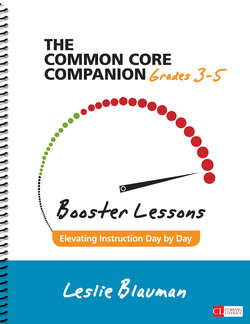Читать книгу The Common Core Companion: Booster Lessons, Grades 3-5 - Leslie Blauman - Страница 67
На сайте Литреса книга снята с продажи.
Third-Grade Adaptation
ОглавлениеIn the fourth-grade sequence, students were comparing the POV between two texts. In third grade, students are determining the POV of the text and then comparing it to their own point of view. Our thinking often changes as we read a text, especially as a character is developed and changes as the text progresses. That’s why it’s important in third grade to stop periodically and determine if the character’s or narrator’s POV has changed and why and if the reader’s reaction to the character has changed—and why.
Third graders need to be able to define point of view and determine who is telling the story.
The purpose of this lesson is to determine who is telling the story and ask questions about their point of view and how the student knows this. During reading, the student should decide if he agrees or disagrees with that point of view.
Once students understand point of view, choose a text with a strong point of view (Michael Teague’s Ike LaRue picture books are excellent for third grade.) As you read, stop and model and think aloud how you would answer these questions:
Who is telling the story and why?
What is the main character’s POV? Stop periodically and note if it’s the same or if it has changed. What causes it to change?
What details help me know this?
As I read, what do I think about the main character? Do I find I agree or disagree with how he behaves? Why? (This is wonderful question to show how as readers we bring our own viewpoints and so each of us may have a different perspective.)
What do I think about things in the end?
On the next day, follow a similar model of gradual release as shown in the fourth-grade lesson and allow students to record their thinking. This could be as simple as having one color sticky notes to identify who is telling the story, and then three other sticky notes numbered 1, 2, and 3 for students to record their answers and thinking to the question “What do I think about the main character . . .” at different points throughout the story.
Finally, have students discuss or record what they think about things in the end.
Continue to practice these skills until students can ask and answer the questions independently.
The Mark Teague books on LaRue (there are four) are all incredibly entertaining. To reinforce short bursts of opinion writing, I will have students write a paragraph explaining which one they like best and why. This is an example of “on-demand” writing where students write a piece in a sitting without revision, for example. These pieces also reflect student writing at the beginning of the year.
OR
